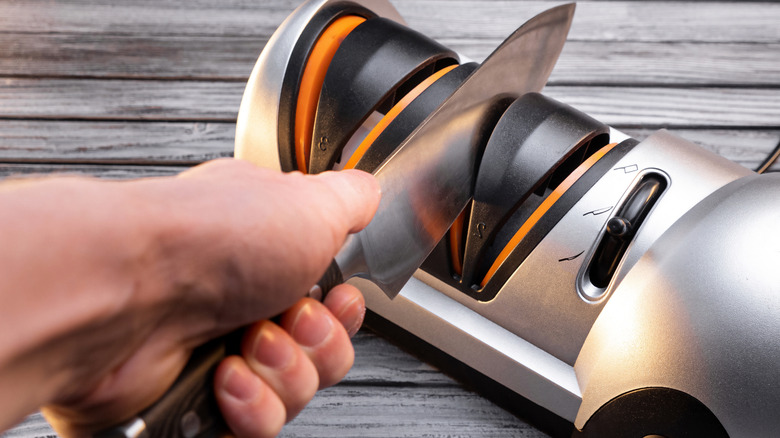Electric Vs. Hand-Sharpening Stones For Knives: Which Is The Better Option?
We may receive a commission on purchases made from links.
A kitchen knife is such an integral part of the cooking process that it has become practically impossible not to use one on a daily basis. Its role is so vital that keeping it sharp is considered an essential step in kitchen maintenance, along with drying the knife, an important part of the cleaning process. Sharp knives make cooking efficient and also prevent any form of injury that could otherwise happen when you use a dull one. Many even say that a dull blade is also dangerous to have in the kitchen.
Luckily, ensuring your knives stay sharp doesn't take too much effort, especially with how accessible tools have become. You don't even need to go to a service center to keep your blades in pristine condition. What is important is avoiding the dangers of not using the proper tools to sharpen knives. There are two primary choices when dealing with a dull knife: electric sharpeners and hand-sharpening stones. Each option has its own set of advantages and disadvantages. For example, an electric sharpener is known for its convenience while a hand-sharpening stone is good for those who value precision.
Choosing the right one depends entirely on a variety of factors, including skill level and even the time you have to do the work. Let's take a closer look at both types of sharpeners to help you make an informed decision.
Electric knife sharpeners are for convenience
People who want quick and consistent results without hassle often opt for electric knife sharpeners since they are known for their convenience and user-friendliness. Beginners, or those who are not used to sharpening knives, find them easier to use since the motorized, abrasive wheels grind and polish the blade edges efficiently. They can sharpen a knife within seconds and produce a uniformly sharp edge without requiring any special skill.
The downside, however, is the automatic nature of electric sharpeners. This limits control over the angle and pressure applied. This might make it harder if you want your blade to have specific features. Using an electric sharpener could also shorten your knife's lifespan since it has the tendency to oversharpen.
The cost of an electric knife sharpener varies depending on the brand and features. For example, the Presto Professional Electric Knife Sharpener currently sells for around $65 on Amazon.
Hand-sharpening stones allow precise work
Another tool used for ultra-sharp kitchen knives, hand-sharpening stones (also called whetstones) are for people who like a more personal approach in maintaining a knife's quality. This is because manually sharpening allows you to better adjust the angle and control the pressure applied to the blade. Using a hand-sharpening stone is also typically the more budget-friendly option compared to pricier electric models. A whetstone from the brand Lanbaoshi currently sells for $16.99 on Amazon, while the bestselling Sharp Pebble Premium Whetstone costs $39.99.
But using hand-sharpening stones requires time and patience in learning the process. It is also challenging to achieve the perfect angle and technique for the right blade quality, especially if you have no prior experience doing the manual method.
Choosing between electric and hand-sharpening stones ultimately depends on your needs. By weighing these pros and cons, you can select the method that aligns with your maintenance goals.


